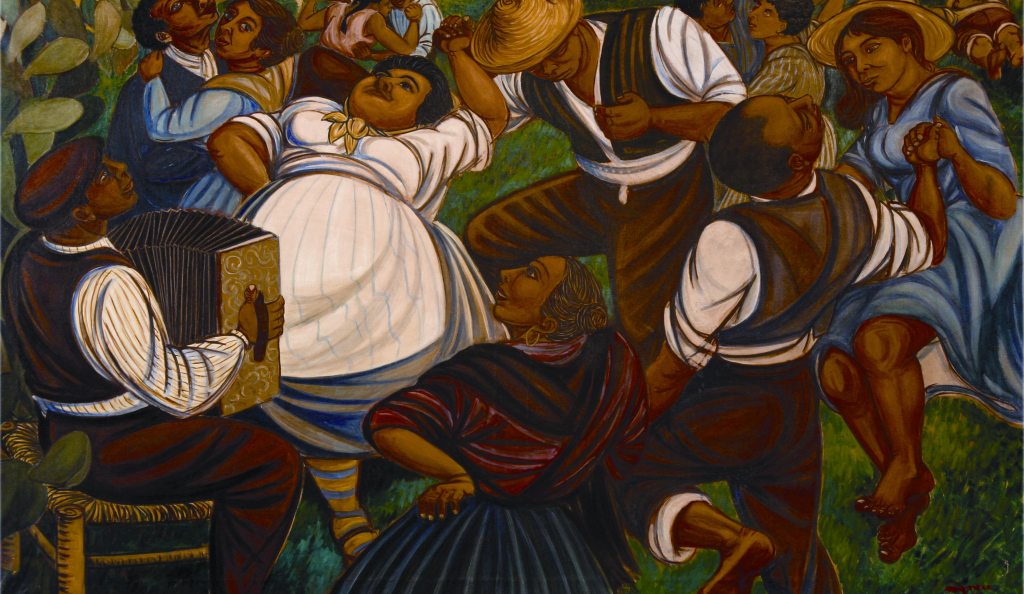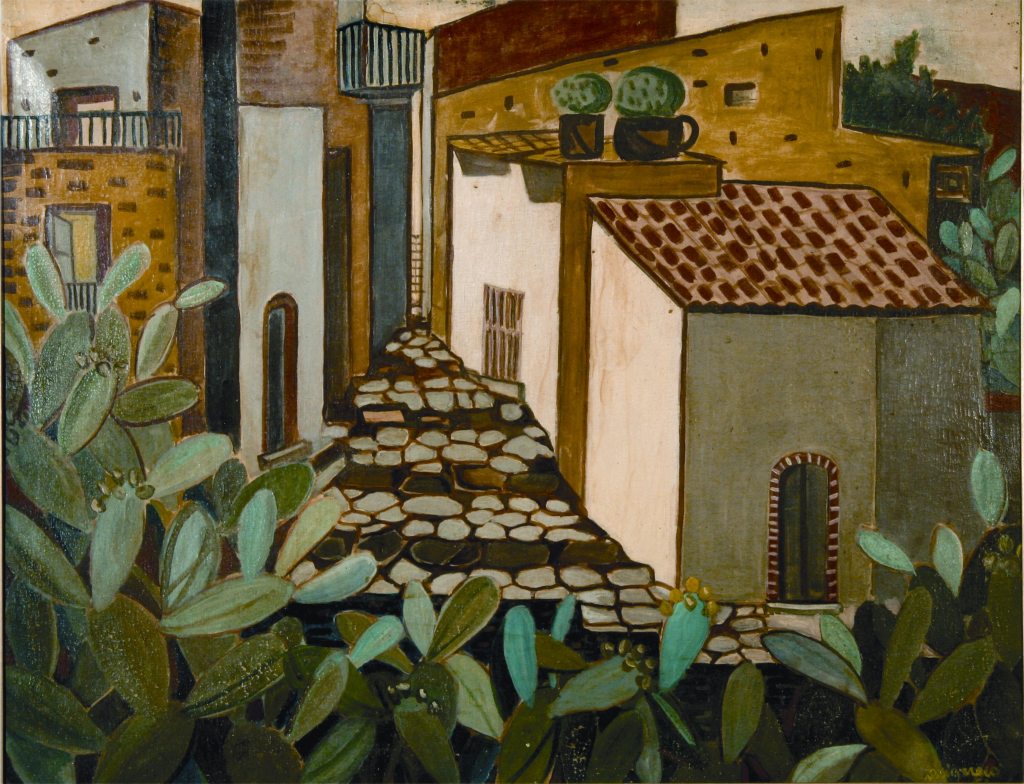GIUSEPPE MIGNECO
Nasce a Messina il 09 febbraio del 1908. Il periodo della sua infanzia, vissuta fra la campagna ed il mare di Sicilia, resterà un felice ricordo del pittore, come di un paradiso perduto che egli ritrarrà in molti suoi quadri.Nel 1931 si trasferisce a Milano e si dedica alla sua carriera artistica, dipingendo inizialmente quadri di contenuto autobiografico. Nel 1934 conosce Renato Birolli, Raffaele De Grada ed Aligi Sassu e, influenzato dalla loro pittura, Migneco comincia a dipingere con nuovo spirito e maggiore sicurezza.Nel 1937 è tra i fondatori del movimento di “Corrente” che raggruppa tutti quegli artisti che rifiutano l’isolamento culturale imposto dalla politica fascista. In “Corrente” affluiscono, nel tempo, Badodi, Birolli, Broggini, Cassinani, Cherchi, Gauli, Guttuso, Manzù, Morlotti, Paganin, Sassu, Valenti, Vedova, tutti artisti con visioni dell’arte molto diverse ma uniti per respingere canoni pittorici ormai superati. Nel 1940 Migneco inaugura la sua prima mostra personale alla Galleria Cairola di Genova. Nel 1942 espone a Milano alla Galleria della Spiga e negli anni successivi alla Galleria San Radegonda di Bertoni a Milano e alla “Galleria del Cavallino” a Venezia.L’opera di Migneco si inserisce nel realismo sociale ma il suo realismo è caratterizzato dall’influsso del muralismo messicano, interpretato con una più rigida e tagliente linearità. Le sue figure ed i suoi paesaggi riportano alla tradizione decorativa e narrativa dei carrettini siciliani, come questi immobili e senza tempo.Negli anni cinquanta Migneco è considerato uno dei maestri dell’arte italiana contemporanea ed espone nelle più prestigiose gallerie nazionali ed estere: Goteborg, Boston, Parigi, Stoccarda, New York, Amsterdam, Amburgo e Zurigo.Espressionista forte e sincero, Migneco non conosce le mezze tinte o i semitoni. I volti dei suoi personaggi sono l’espressione di una terra dura che dispensa dolore e fatica.Migneco muore nel 1997 a Milano.
 BALLO DI CONTADINI
BALLO DI CONTADINI
1953 - olio su tela, cm 120x200
Il dipinto, raffigurante una festa contadina, sembra rifarsi alla pittura messicana.La rappresentazione della realtà, tipica e costante per l’artista siciliano, qui appare smorzata ed è possibile scorgere, al di là della scena di allegria, nostalgia ed amarezza.
Scheda Catalogo
 PAESAGGIO DI CASTELMOLA
PAESAGGIO DI CASTELMOLA
1951 - olio su tela, cm 70x90
Il dipinto, raffigurante un paesaggio di Castelmola, è il frutto di una “gita” durante la quale Migneco, respirando l’aria di casa, si allontana dalle sue maturate esperienze sulla scia di Van Gogh e dal cubismo ripensato che lo avevano portato a dipinti quali “Raccoglitori di fichi d’India” anche se nel “Paesaggio di Castelmola” è presente, anche se pittoricamente più caricato, il motivo delle pale di fichi d’India che aprono la scena su uno scorcio del paese reso in maniera realistica e molto strutturato su un disegno semplice. Scheda Catalogo
 Giuseppe Migneco - Was born February 9, 1908 in Messina. His childhood season, lived between the country and the sea of Sicily, it will be an happy memory ofthe painter, as of a lost paradise that he will paint in many his paintings. In 1931 he moved to Milan and he devoted himself to his artistic career, painting at first paintings with autobiographical contents. In 1934 he knew Renato Birolli, Raffaele De Grada and Aligi Sassu and, affected from their painting, Migneco started to paint with a new temper and greater trust.In 1937 he was one of the founders of the movement “Corrente” that groups together all those artists who refuse the cultural isolation imposed from fascist politics. In the course of time, Badodi, Birolli, Broggini, Cassimani, Cherchi, Gauli, Guttuso, Manzu’, Morlotti, Paganin, Sassu, Valenti, Vedova pour in “Corrente”, they are all artists with very different views of the art but united to refuse pictorial canons by that time outdated.In 1940 Migneco started his first solo show at the Galleria Cairola of Genova. In 1942 he exhibited at the Galleria of the Spiga in Milan and in the years after at the Galleria San Radegonda of Bertoni in Milan and at the “Galleria of the Cavallino” in Venezia.The work of Giuseppe Migneco fits in the social realism but his realism is characterized by influence of the mexican muralism, interpreted with a firmer and sharp plain dealing. His figures and his landscapes carry back to decorative tradition and narrative of the Sicilian carts, as these still and without time.In the fifties, Migneco is considered one of the masters of Italian contemporary art and he exhibits in the most important galleries, national and foreign: Goteborg, Boston, Parigi, Stoccarda, New York, Amsterdam, Amburgo and Zurigo.Strong and true expressionist, Migneco doesn’t known half-paints or half-tone. The faces of his figures are the expression of a hard country that dispenses pain and toil.Migneco died in 1997 in Milan.
Giuseppe Migneco - Was born February 9, 1908 in Messina. His childhood season, lived between the country and the sea of Sicily, it will be an happy memory ofthe painter, as of a lost paradise that he will paint in many his paintings. In 1931 he moved to Milan and he devoted himself to his artistic career, painting at first paintings with autobiographical contents. In 1934 he knew Renato Birolli, Raffaele De Grada and Aligi Sassu and, affected from their painting, Migneco started to paint with a new temper and greater trust.In 1937 he was one of the founders of the movement “Corrente” that groups together all those artists who refuse the cultural isolation imposed from fascist politics. In the course of time, Badodi, Birolli, Broggini, Cassimani, Cherchi, Gauli, Guttuso, Manzu’, Morlotti, Paganin, Sassu, Valenti, Vedova pour in “Corrente”, they are all artists with very different views of the art but united to refuse pictorial canons by that time outdated.In 1940 Migneco started his first solo show at the Galleria Cairola of Genova. In 1942 he exhibited at the Galleria of the Spiga in Milan and in the years after at the Galleria San Radegonda of Bertoni in Milan and at the “Galleria of the Cavallino” in Venezia.The work of Giuseppe Migneco fits in the social realism but his realism is characterized by influence of the mexican muralism, interpreted with a firmer and sharp plain dealing. His figures and his landscapes carry back to decorative tradition and narrative of the Sicilian carts, as these still and without time.In the fifties, Migneco is considered one of the masters of Italian contemporary art and he exhibits in the most important galleries, national and foreign: Goteborg, Boston, Parigi, Stoccarda, New York, Amsterdam, Amburgo and Zurigo.Strong and true expressionist, Migneco doesn’t known half-paints or half-tone. The faces of his figures are the expression of a hard country that dispenses pain and toil.Migneco died in 1997 in Milan.
DANCE OF FARMERS - 1953 - It’s an oil on canvas - The painting, depicting a peasant festival, seems to refer to the Mexican painting. The representation of reality, typical and constant for the Sicilian artist, here is muted and you can see, beyond the scene of joy, longing and bitterness.
LANDSCAPE OF CASTELMOLA - 1951 -It’s an oil on canvas, cm 70x90 - The painting, depicting a landscape of Castelmola, is the result of a trip, during which, Migneco, breathing the air of the house, he turns away from his experience gained in the wake of Van Gogh and by thought Cubism that led him to paintings such as “Pickers prickly pears” even though in the “Landscape of Castelmola” is present, even if pictorially more loaded, the theme of the blades of prickly pears that open the scene of a glimpse of the country made in a realistic way and well-structured on a simple design.